It is a safari site that will never be forgotten, ranking among Tanzania’s top three parks with some of the highest animal densities in the nation and massive herds of elephants. In addition to fauna, it boasts stunning scenery with tall baobab trees and yellow meadows. Of course, there is also the Tarangire River, which meanders through the park and draws wildlife to its banks.
Many of the major swamps are situated east of the Tarangire River, which flows through the middle of the park.
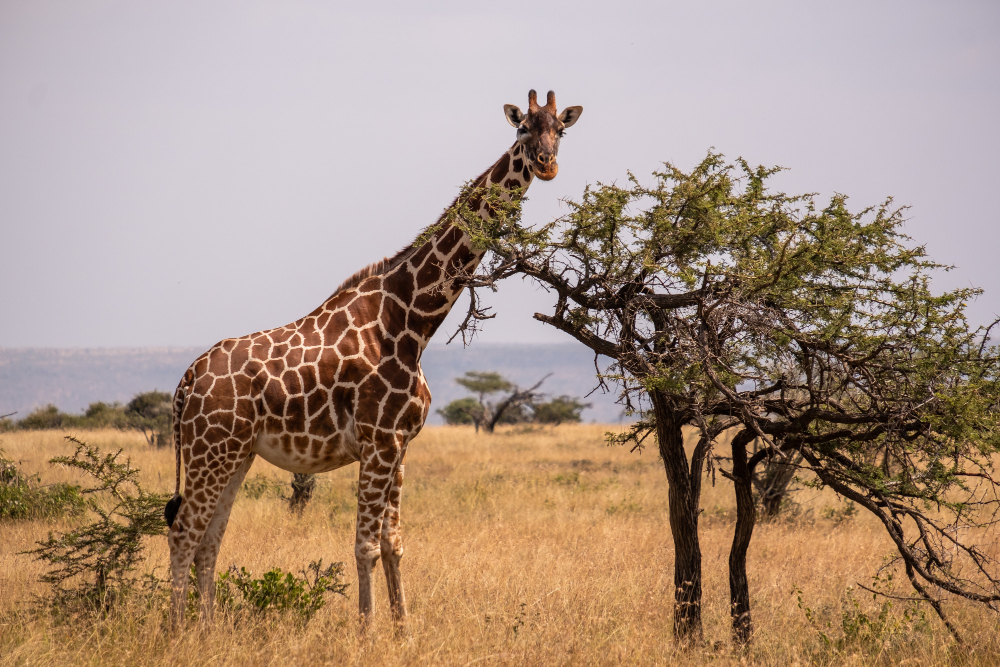
Many safaris stay in the northern part of the park, which is where the main gate is located. However, if you have two or more days, going to the south offers a more peaceful and wild safari experience, with fewer safari vehicles and some uncommon animals to see among the vast wetlands.
Tarangire National Park
Tanzania’s greatest elephant herds can be found in Tarangire National Park, the sixth-largest park in the nation.
It is a component of the nation’s Northern Safari Circuit, which includes Lake Manyara National Park, Arusha National Park, and several national parks and nature reserves, like as the renowned Serengeti National Park and Ngorongoro Crater.
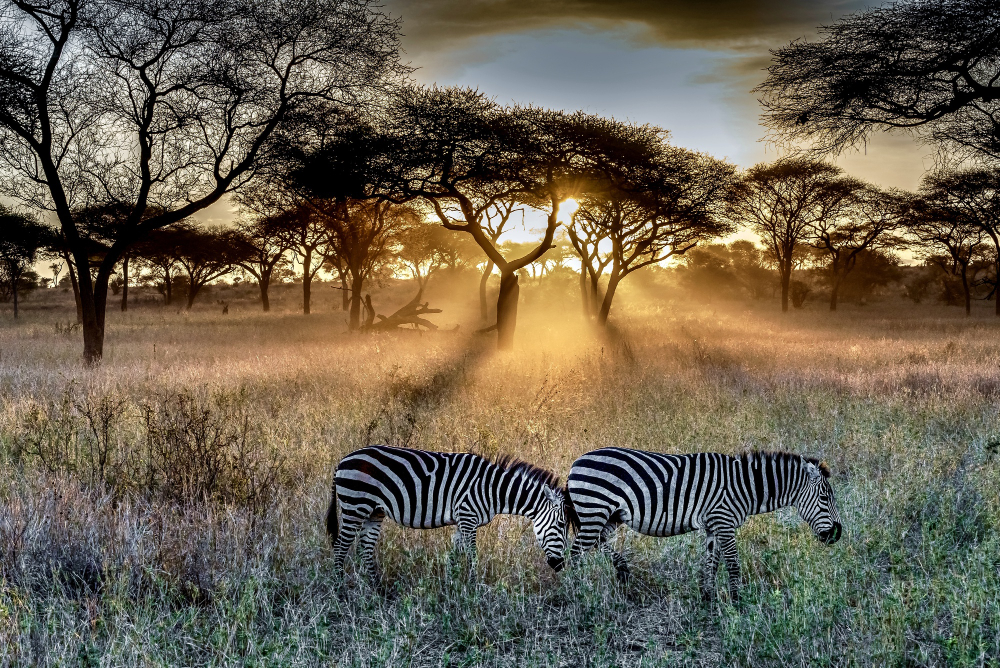
What is the Size of Tarangire National Park
Tarangire National Park is the sixth largest park in Tanzania, covering 1,770 square miles (4,583 km²). Compared to the nearby Lake Manyara National Park, which is only 202 square miles (523 km2), it is much larger.
The renowned Serengeti, which is located in Northern Tanzania, is on the other end of the spectrum. It is over three times as large as Tarangire, spanning 5,700 square miles (14,763 km²). At roughly 3,200 square miles (8,288 km2), Tarangire is only about half the size of the Ngorongoro Conservation Area.
Why is Tarangire National Park Special
Tarangire National Park is a great destination for a first-time safari experience because it offers one of Tanzania’s highest animal concentrations, particularly during the dry season, including thousands of elephants.
The amazing sights of young and old elephants playing and bathing in the park’s water holes, as other animals slake their thirst, are simply unbeatable.
Ancient baobab trees, some of which have stood watch over the savannah for two millennia, are another reason for the park’s fame.
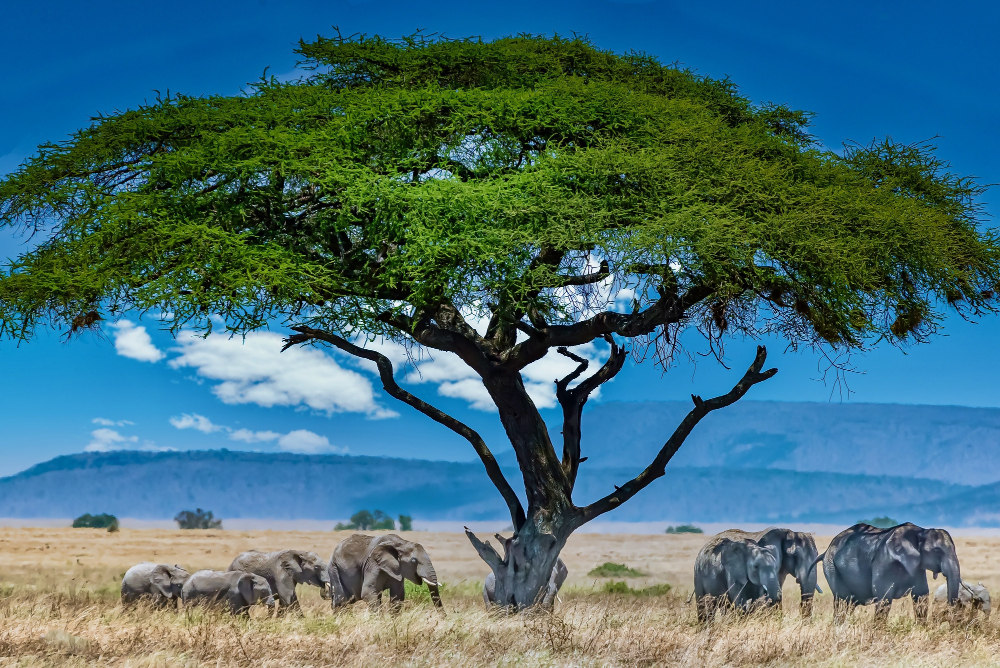
Tarangire is a fantastic starting point for your Tanzania safari because it is also reachable from Arusha. The three locations comprise Tanzania’s Northern Safari Circuit, along with the Serengeti and Ngorongoro, and many travelers opt for a tour that enables them to see all three. This, in my opinion, is an excellent approach to see what makes Tanzania so unique.
Tarangire’s Elephant Herds
Large herds of elephants are a well-known feature of Tarangire National Park. One of the main reasons people enjoy going on safari here is because of these famous giants.
Given that Tarangire contains the greatest number of elephants in northern Tanzania, it is not surprising that you have a good chance of sighting them. You might see up to 100 elephants in one sighting when on safari in Tarangire!
This is where I saw my first elephant. As they made their way to the water hole, a whole herd—including a very young baby—walked ahead of us. It was heartwarming to watch them sip while the infant rolled happily in the water. Later, I also witnessed some bull elephants and a breeding herd cross paths, and they all started grazing together.
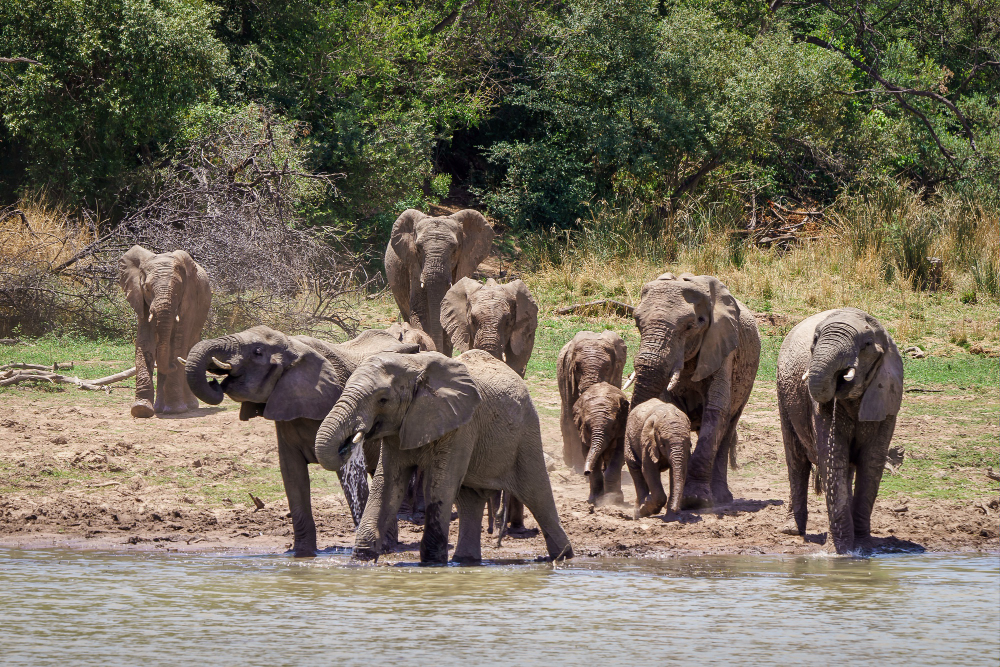
The dry season, which runs from June to October, is the ideal time of year to witness Tarangire’s elephants. Along the banks of the Tarangire River, which serves as the park’s main water source, they are visible during this period.
Although the number of elephants in this area is steady, the creatures are constantly under danger from a variety of sources, including poaching and human activity.
Five of the main elephant migration routes have already been lost as a result of local agricultural activity disrupting the corridors in Tarangire and the adjacent area. Because they connect the park to water outside the boundaries and mineral-rich grazing ground, the animals depend on these old passageways.
Since 1993, the Tarangire Elephant Project has been tagging and identifying elephants to help fight these dangers. Their research contributes to the preservation of grazing areas and natural ecosystems by tracking their movements, behavior, and genetic makeup, allowing local populations and animals to live in harmony. In order to counter the threat of illicit activities, anti-poaching patrols have also been organized. In Tarangire, the most sought-after animals for safari sightings are elephants. You will never forget witnessing them trundling across the grasslands, sometimes in their hundreds, as they live here in enormous numbers.
Rarest Animals in Tarangire
Keep an eye out during your game drive because Tarangire National Park is home to several rare and endangered species.
It is one of the best sites in Tanzania to see the larger kudu, one of the largest antelope species, and the fringed-eared oryx, a subspecies of the Beisa oryx. Males of this species have amazing spiral horns that can reach a length of 1.8 meters (6 feet). Try to identify the gerenuk. This peculiar gazelle is renowned for feeding on the leaves of low tree branches while standing on its hind legs.
African wild dogs, which travel great distances throughout Tanzania, have been spotted occasionally in Tarangire. In northern Tanzania, there aren’t many African wild dogs. Nonetheless, they flourish in the huge parks of Ruaha National Park and Nyerere National Park in Southern Tanzania.
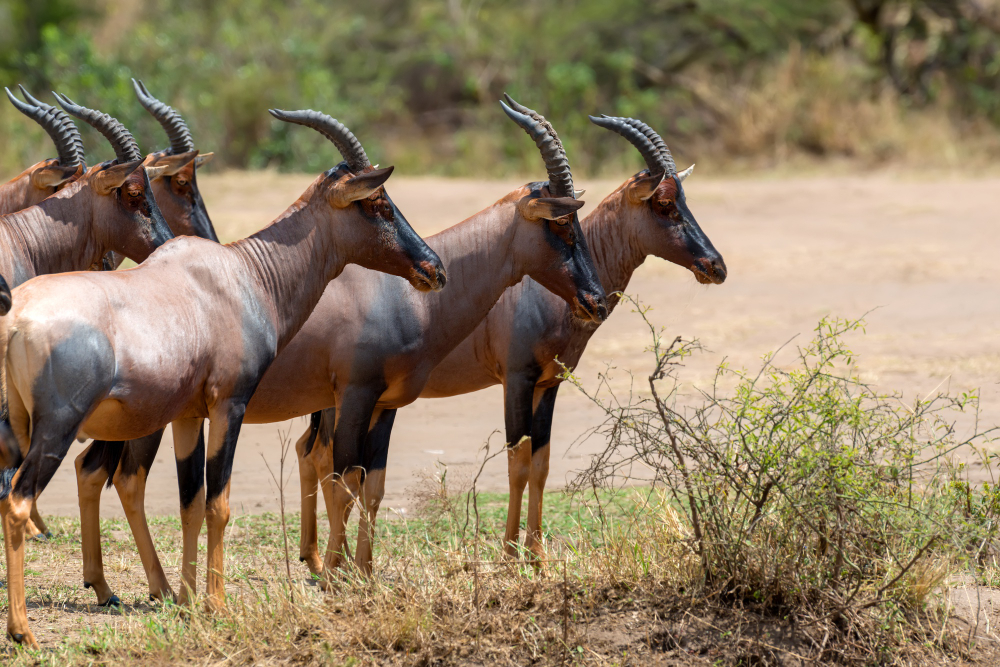
Approximate number of Elephants in Tarangire
In Tarangire National Park, there are more than 3,000 elephants, with some herds consisting of as many as 200 animals. Along with Kenya’s Amboseli National Park, this is unquestionably the greatest spot in Tanzania to see elephants, and among the best in Africa; however, sightings are never assured.
Tarangire Migration
There is a lot of migratory activity in the park, particularly during the dry season, while water is still available, because the Tarangire River is one of the main water sources in northern Tanzania. The herds are, nevertheless, quite stunning, even though they aren’t comparable to those of the Great Wildebeest Migration in Kenya’s Masai Mara and Tanzania’s Serengeti.
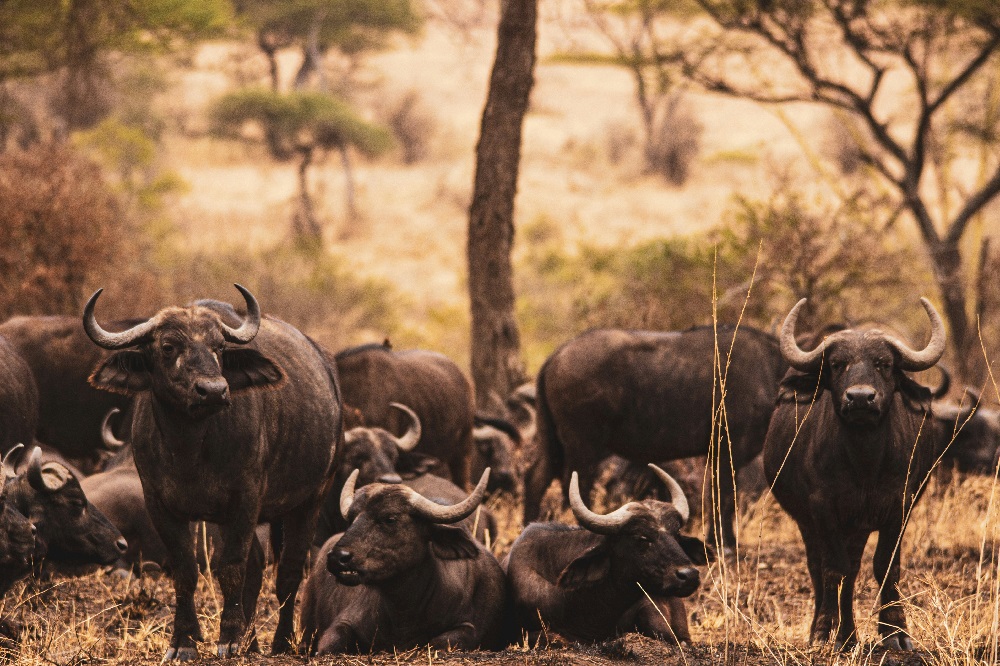
Visit Tanzania in August, September, or October, when the dry season is at its height, if you want to see the Tarangire migration. Around the few remaining watering holes in the Tarangire River, thousands of wildebeests, antelopes, zebras, and elephants congregate.
Tarangire Baobab Trees
The profusion of enormous baobab trees, some of which are thought to be as old as 2,000 years, is another highlight of a Tarangire safari. These amazing boabobs are impossible to overlook; they may reach a height of 30 meters and frequently have trunks that are 11 meters broad.
There are hundreds of baobabs scattered across the plains, and you will often see them when you go on game drives in the park. Remember to glance above to check whether there are any leopards concealed in the dense trees! You can get an excellent look at these elusive large cats at Tarangire.
Because they retain moisture, baobab trees are referred to as the “trees of life” and support local fauna. The trees are especially popular with nesting birds, elephants, and smaller animals like mongooses.
Between October and December, the trees only bloom once a year on a single night. It’s rare to see these, but if you time it correctly, you can see the white flowers drawing bats and insects.
Tarangire’s History
One of Tanzania’s oldest national parks, Tarangire gets its name from the river that flows through it. It is located on the Great Rift Valley’s eastern flank, which was created millions of years ago. However, Tarangire hasn’t been a national park for long.
Since the 16th century, Maasai pastoralists have inhabited the area, exploiting the territory for hunting and grazing. The Maasai were then driven from their homeland during British colonial control in the 19th and 20th centuries so that European farmers might cultivate their land.
In order to protect the area’s wildlife and stop hunting, the colonial authorities declared Tarangire a game reserve. In 1970, Tarangire was elevated to the status of a national park in honor of its unique habitats, natural riches, and profusion of animals.
The Tanzania National Parks Authority is currently in charge of managing Tarangire, controlling tourists, and supervising local animal conservation. The park has been at the forefront of Tanzania’s conservation initiatives and has been essential to the growth of environmentally friendly travel in the nation.
Animals in Tarangire
Tarangire National Park boasts some of Tanzania’s most diverse wildlife species because of its diverse range of habitats. Predators like lions, leopards, and hyenas, as well as a variety of antelope species and plains game like giraffes and zebras, thrive in the forests, marshes, and grassland savannahs.
With 3,000 of them in the park, elephants are the most visible of all the creatures.
During the dry season, when animals congregate near the Tarangire River, Tarangire National Park is thought to have one of Tanzania’s largest wildlife populations, second only to the Serengeti. Some of the simplest to identify are giraffes, impala, warthogs, zebras, wildebeest, and eland.
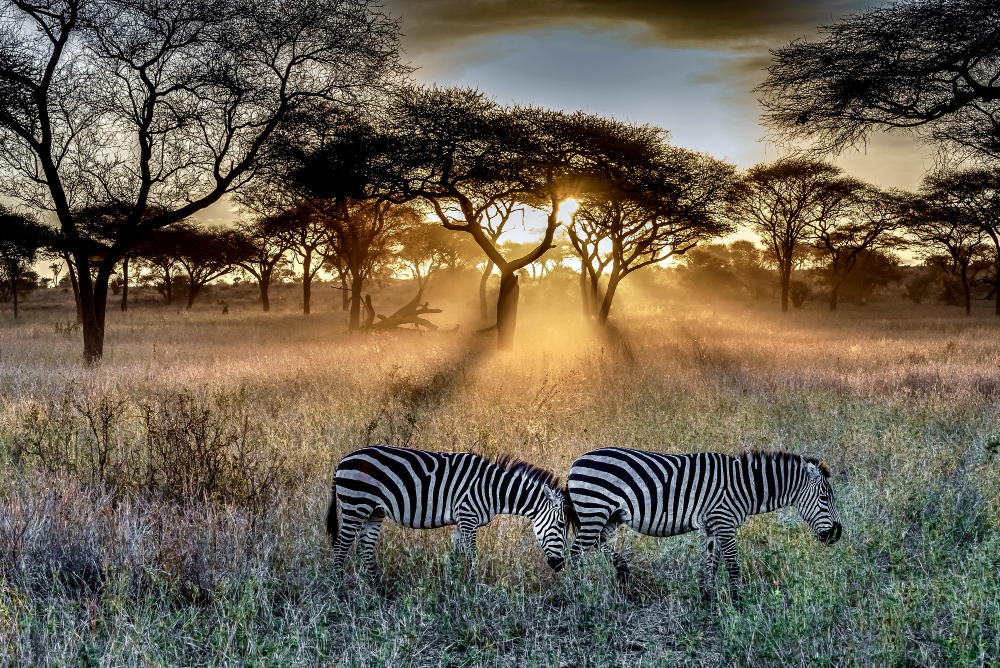
However, Ngorongoro Crater frequently equals or surpasses Tarangire in terms of steady animal density throughout the year because of its contained ecology and resident wildlife populations.
Regarding ungulates (animals with hooves), Tarangire is home to 10,000 wildebeests in addition to numerous zebras, impalas, gazelles, antelopes, buffalos, giraffes, and small dik-diks.
With a population of about 7.5 lions per 100 km2, you’re sure to spot some of the 250 lions that call this place home. I saw lions resting on the other side of the river, which was amazing.
During your wildlife drive, you may also come across spotted hyenas. Although their precise population in Tarangire is unknown, the park is home to a large number of them. The cheetahs and leopards, on the other hand, are somewhat more elusive.
Although sightings of African wild dogs have occurred, they are extremely uncommon and unpredictable.
Primate populations abound in Tarangire, including sizable herds of olive baboons that are commonly spotted along the game paths. Don’t leave your sandwiches unattended because vervet monkeys frequently congregate at picnic sites in the hopes of obtaining a free lunch!
Are there Big Five in Tarangire
Tarangire National Park has the Big Five. Although there are buffaloes, lions, elephants, and leopards here, rhinos are not.
While leopards can be harder to spot, lions, elephants, and buffalo are generally common.
The adjacent Ngorongoro Crater, which is typically included with Tarangire on your Tanzania safari trip, is one of the greatest spots to watch rhinos. The greatest time to see the few endangered black rhinos in Ngorongoro Crater is around sunrise, just before they disperse to go foraging.
There are over 250 lions in Tarangire, making them the most prevalent predators. You have a good chance of seeing a lion during your safari because they are observed almost every day, especially during the long dry season. Hippos can be found in the Tarangire River and wallowing in the surrounding marshes; during the dry season, when water levels are low, they are very visible.
Due to extensive poaching in the 20th century, rhinos have been absent from Tarangire for the past few decades.
Because of the park’s strong anti-poaching measures, black rhinos can still be found in the Serengeti and Ngorongoro Crater, but if you’re traveling the entire Northern Circuit, you might see them elsewhere.
Ngorongoro Crater is your best option because it is home to a small population of endangered black rhinos, which are best viewed at sunrise before they disperse to forage.
In Tarangire, Nile crocodiles can be seen. The Tarangire River and the surrounding wetlands are the finest locations to see them; there, they might be swimming in the shallows or relaxing on the shore.
The greatest times to see wildlife are during the dry season when they gather near water sources. Although the precise number is unknown, estimates place it in the low hundreds.
Tarangire is home to Maasai giraffes, which are frequently spotted during game drives in the national park. They can be found in both woodland and plain environments, where they eat the leaves of their favorite acacia trees.
An estimated 1,377 giraffes were found in Tarangire National Park and the nearby Game Controlled Areas in 1991, according to an aerial survey.
Bird watching in Tarangire.
With its enormous populations of both native and migratory species, Tarangire is a favorite spot for bird watchers. Tarangire is home to more than 550 species, including several endemic and unusual birds.
For the best views, go to the hills, bogs, and woods. Rufous-tailed weavers, hornbills, kori bustards, yellow-collared lovebirds, ostriches, Nubian woodpeckers, and eagles are among the common animals found in Tarangire.
Since animals are easier to observe during the dry season, most visitors travel to Tarangire during this time. However, the rainy months of November through March are the ideal times to visit for birds.
The diversity of birds in Tarangire is increased by the influx of migrating bird species from Asia and Europe during the rainy season. Additionally, local bird species are nesting, so their plumage will frequently be colorful.
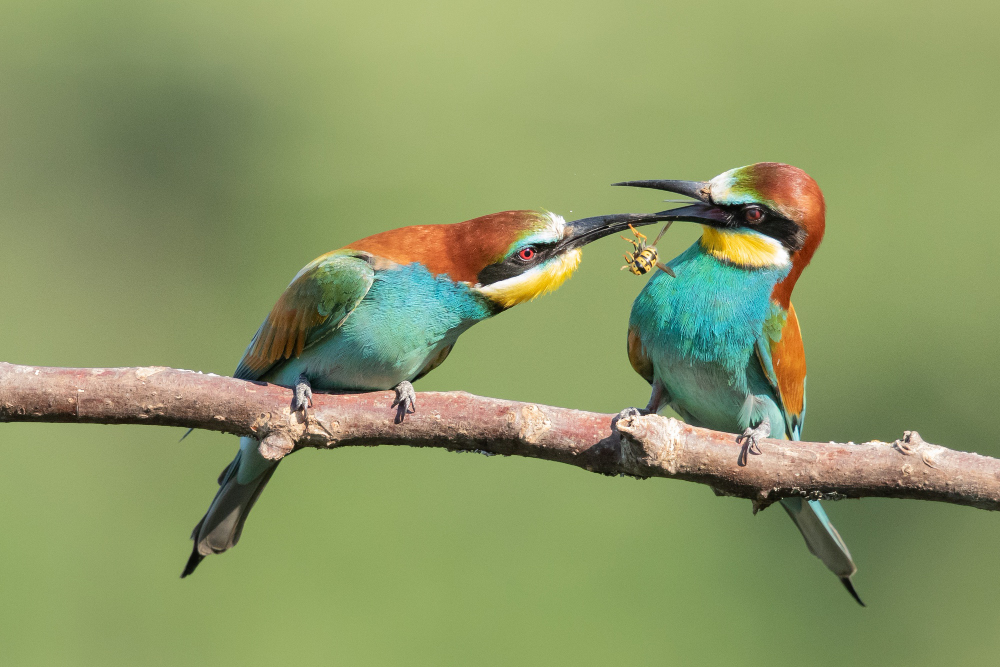
Wildlife Conservation in Tarangire
In order to protect the local wildlife, local communities and non-governmental organizations collaborate with the Tanzanian government and international organizations.
Since 1993, the Tarangire Elephant Project has been one of the primary projects. Its goal is to manage the ecosystem sustainably by doing research and providing local communities with training.
To guarantee that animals like elephants can continue to travel freely between natural water and mineral sources, a significant portion of the effort involves maintaining the network of wildlife corridors in and around Tarangire.
It is crucial to preserve the habitats and migration routes next to Tarangire since many species leave the park for several months of the year. In order to protect the ecosystems on the village lands adjacent to the park, the Tarangire Conservation Area was created. Involved in the area’s management, residents benefit from low-impact tourism activities while also protecting wildlife.
In Tarangire National Park, anti-poaching initiatives are also in place. To discourage possible poachers and apprehend those engaged in unlawful activities, patrols are conducted regularly.
Threat to Tarangire National Park
Conflict between people and wildlife is one of Tarangire’s biggest problems. Wildlife corridors are being disrupted by the growing agricultural practices and animal grazing on the land surrounding the park. Animals that have traditionally utilized these conventional pathways between water and mineral sources depend on these corridors. The local Maasai communities act as stewards to preserve the land and its priceless environment, while local charities are putting out a lot of effort to address these problems.
Additionally, Tarangire and all of Africa are increasingly at risk from climate change. Extreme weather variations are causing wildlife populations to dwindle and vegetation to become unbalanced in Tarangire. Animals are being forced to alter their behaviors by looking harder and further for water as a result of the dry season’s growing scarcity.

Climate in Tarangire
The rainy seasons, which occur from March to May and November to February, control Tarangire’s climate. The unpredictability of the precipitation in recent years has occasionally resulted in drought conditions. The park’s wildlife and vegetation are both impacted by the scarcity of water.
Tarangire has warm temperatures all year round, ranging from roughly 24 to 30°C. During the night, the temperature decreases to about 13°C. Therefore, if you’re going on a nighttime game drive, bring warm clothes.
Dry Season in Tarangire
Animals gather in places where they can still find water, such as river pools and wetlands, making them easier to notice during the long, dry season, which is an excellent time to come. Because there is less vegetation during certain seasons, lions and leopards can be seen more clearly up in the trees.
These months offer not only excellent game viewing opportunities but also good weather and a lower risk of malaria.
The drawbacks include higher costs and larger crowds because this is the busiest time of year for tourists; if you decide to go during these months, I advise making reservations well in advance.
The rainy season in Tarangire
There are still plenty of creatures to observe all year round, including elephants, but many migratory species have relocated north out of Tarangire during the wet season, which runs from November to May.
Even though these months fall within the brief rainy season, you should expect some dry weather during the day because the worst weather typically occurs in the afternoon. Additionally, it usually doesn’t get too hot or chilly.
Fewer safari cars are vying for sightings when you visit during the off-peak months, and lodging and tour costs are frequently less expensive.
Days to Spend in Tarangire
All of the important species in Tarangire National Park can be seen in a single day. However, I would suggest spending two days if you like to explore the park’s southern region.
If you have longer, it’s one of the best parks in Tanzania, so you could spend a week or more if you’re really into animals or photography.
If you’re going to the park by car, keep in mind that the 87-mile drive from Arusha to Tarangire takes about two to three hours, so account for this in your itinerary.
Tarangire River
Many safari activities are concentrated near the Tarangire River, which flows through the center of the national park. Since the river serves as Tarangire’s primary water source, game viewing is excellent here.
For the finest wildlife sightings, visit during the dry season when water levels are low. Lions and leopards, as well as migratory species like buffalo, zebras, and wildebeests, are drawn to the river.
Elephants can frequently be seen digging on the sandy banks to find the subterranean water in this area, which is very good for seeing them.
Swamps in Tarangire
Numerous sizable marshes in Tarangire serve as crocodiles and hippopotamus’ preferred hangouts. There are a lot of animals here because the marshes are one of the few sources of water that survive during the dry season. For the greatest viewing conditions, travel to Tanzania between June and October or in January and February.
The Tarangire River receives its water from the majority of the marshes in the park’s eastern and southern regions. Gurusi, Silale, and Larmakau are Tarangire’s three principal swamps. Lions, leopards, and tree-climbing pythons can all be seen here.
Matete Woodland
The reed beds and towering elephant grass that border the riverbanks in western Tarangire are the hallmarks of the Matete Woodlands. This is one of the greatest spots in the park to see leopards, if you want to. The acacia trees may be lucky if you look up into them!
Lions, bushbucks, giraffes, and the endangered fringe-eared oryx can all be found in the forests. From here, you can also get nice views of Lolkisale Mountain.
Kitibong Hill
Kitibong Hill, located west of Tarangire, is well-known for its massive herds of Cape buffalo, which flourish on the acacia plains there. Keep a lookout since your chances of seeing the packs of wild dogs are better here than in most other areas of the park, though they are still erratic and uncommon.
Kitibong Hill is also home to a wide variety of birds, particularly ground hornbills. These eye-catching ground-dwelling birds, in contrast to their counterparts, prefer to run rather than fly when they feel threatened.
Grassland Plains
You’ll be trundling through the bush in your safari vehicle for a considerable amount of time on the plains. Elephants are frequently spotted here, and this is the greatest spot to watch plains animals, including gazelles, buffalo, and wildebeests.
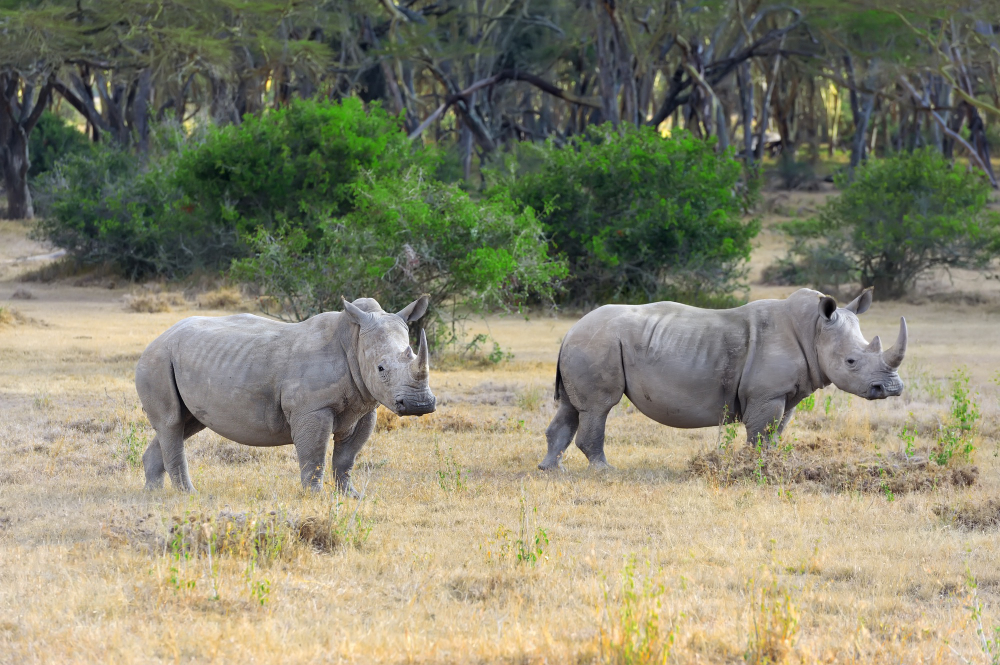
Famous landmarks like the enormous baobabs and peculiar sausage trees can also be seen on the plains. Lions and leopards, which are occasionally spotted up on the branches, prefer the latter. Additionally, keep an eye out for the enormous red termite mounds, some of which are as tall as a person.
Lemiyon Triangle
Known for its diverse vegetation, this triangle wilderness area is located in the park’s far north. This is the spot to go if you want to see the enormous baobab trees.
Raptors are frequently spotted circling overhead in the Lemiyon Triangle, making it an excellent location for bird watching. Additionally, you will have the opportunity to witness large groups of red-billed quelea birds.
Birungi
In the west of the park, the Birungi circuit is a rocky and isolated track that winds through 50 miles of secluded animal habitat.
The enormous eland antelope and the smaller lesser kudu, which prefer the bush flora here, can be seen here.
Is Tarangire National Park safe for Safaris?
Tarangire is a secure place to go on safari, and hundreds of visitors enjoy their time there each year. However, like with any place, it’s prudent to think about the possible hazards in the area.
Health and Diseases
Food poisoning is a risk whenever you travel overseas, particularly in more rural locations or local markets where hygienic standards are lower than those you’re accustomed to at home.
Nonetheless, Tarangire’s hotels and camps are designed to accommodate visitors and take numerous safety measures to guarantee that your food is prepared in accordance with Western standards.
Generally speaking, if you have a sensitive stomach, stay in a mid-range or luxury hotel instead of a cheap one to be safe with your diet. If you have a sensitive stomach, seafood (especially fish), salad, and ice cubes might not be the best choices.
Balloon Safaris in Tarangire
A unique safari experience is provided by Tarangire balloon rides, which offer a whole different viewpoint of the park from above. These journeys necessitate an early start, but nothing compares to drifting slowly across the sky while taking in the sunrise over the African plains.
Since balloon rides often last an hour, you have plenty of time to take in the scenery. From this height, you can see how big Tarangire is, and it’s also simple to identify the herds of animals.
After your flight, you’ll typically enjoy a champagne brunch in the bush to round off the experience. In the middle of nature, this is a great way to toast your expedition.
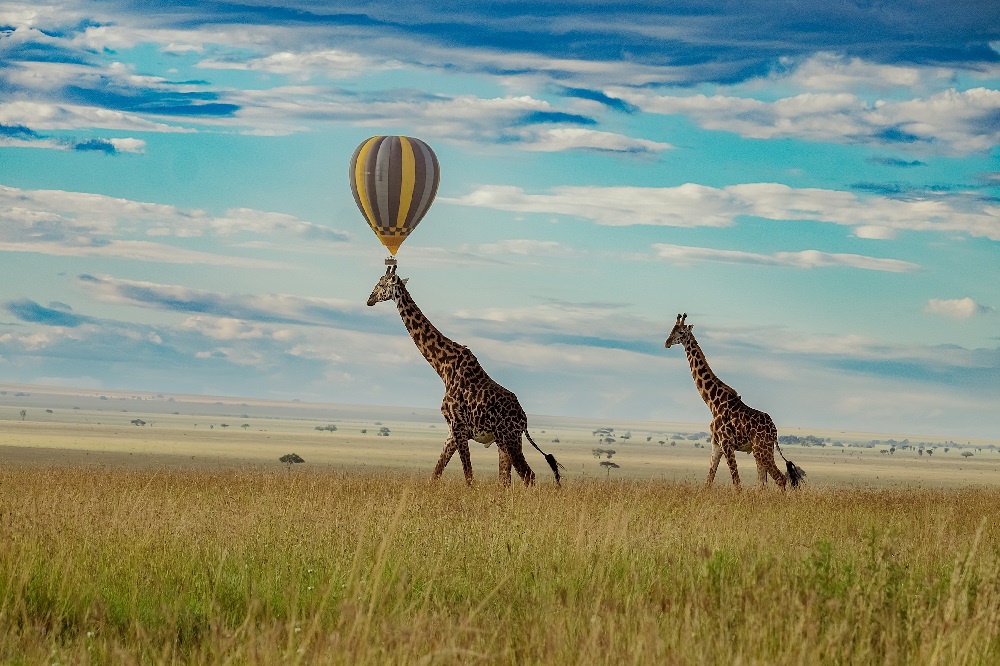
Nature Walks in Tarangire
For a walking safari, Tarangire is an excellent destination. You will feel as though you are in the middle of the wilderness when you walk across the landscapes and follow animal trails to look for wildlife.
You will have the opportunity to gain firsthand knowledge of the local surroundings while accompanied by a knowledgeable guide. Because walking safaris don’t disturb the animals, you’ll probably see a few things that you wouldn’t ordinarily see on a game drive.
Since more animals are out and about in the early morning or late afternoon, these times are ideal for walking safaris. The experience is more enjoyable because the temperatures are also lower than.
Photography in Tarangire
Because of its rich vegetation, plenty of wildlife, and different scenery, Tarangire is a popular site for photography safaris. Photographers travel here to capture the distinctive African grasslands, the ancient baobab trees, and the massive herds of elephants.
Morning and sunset game drives provide the finest light conditions when the sun isn’t directly overhead, making them the ideal times for photographic safaris. There is a lot of darkness during these periods, which can add depth and dramatically improve a wildlife photograph.
Is Tarangire worth a visit?
Even though the Serengeti and Ngorongoro Crater are more well-known, Tarangire provides a less expensive, just as fulfilling, and comprehensive safari experience.
One of the best places in Africa to witness these gentle giants is Tarangire National Park, which is home to Tanzania’s largest herds of elephants.
It makes sense to stop at the park on your journey to or from Arusha because it is situated on the route to the Serengeti and Ngorongoro Crater.
Along with Arusha National Park, Tarangire is one of the few parks that permits walking safaris, making it an excellent destination for such experiences. Walking safaris are currently prohibited in the Serengeti and Ngorongoro Crater, specifically on the crater floor.
Accommodation in Tarangire
-
lodges
Remaining in a permanent building with sturdy walls is the first choice. These are frequently called hotels or lodges. In and near Tarangire, there are a few lodge choices.
Offering bungalows or thatched tented suites, Tarangire Safari Lodge is well-liked by those seeking a more authentic wilderness experience. It has a swimming pool and unparalleled views of the Tarangire River’s animals from its clifftop location, which is approximately 6 miles inside the park gate.
-
Safari Camps
In contrast to lodges, tent or safari camps are frequently constructed of canvas instead of sturdy walls. This gives you the best Out of Africa experience and helps you feel more connected to nature. They are frequently more exclusive than lodges and are unquestionably just as opulent. In my opinion, they are the best choice.
Oliver’s Camp is located next to the Minyonyo Pools in the center of Tarangire National Park. It’s a chic and cozy camp with a traditional feel, personalized service, and dining under the stars.
Staying at Sanctuary Swala Camp will put you right in the middle of the action because it is located deep within the park. The opulent accommodations with canvas tents offer stunning views of the savannah and a drinking hole that draws elephants.
-
Camps
Basic ground camping is the third and last type of lodging. Here, you’ll set up your tent on a free place, spread out your sleeping bag, and use the shared restroom.
The Tarangire Public Campsite No. 1 is the greatest option if you’re on a tight budget. It is located within the park, roughly three miles from the headquarters and entrance gate. You will need to bring your own food and drinking water, although there are showers and toilet facilities as well as a grilling area.
